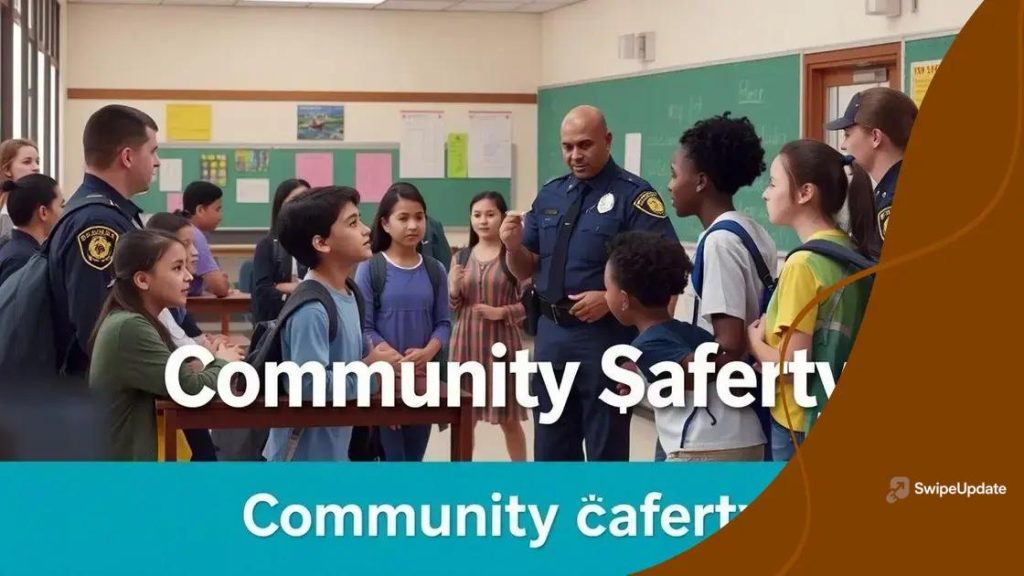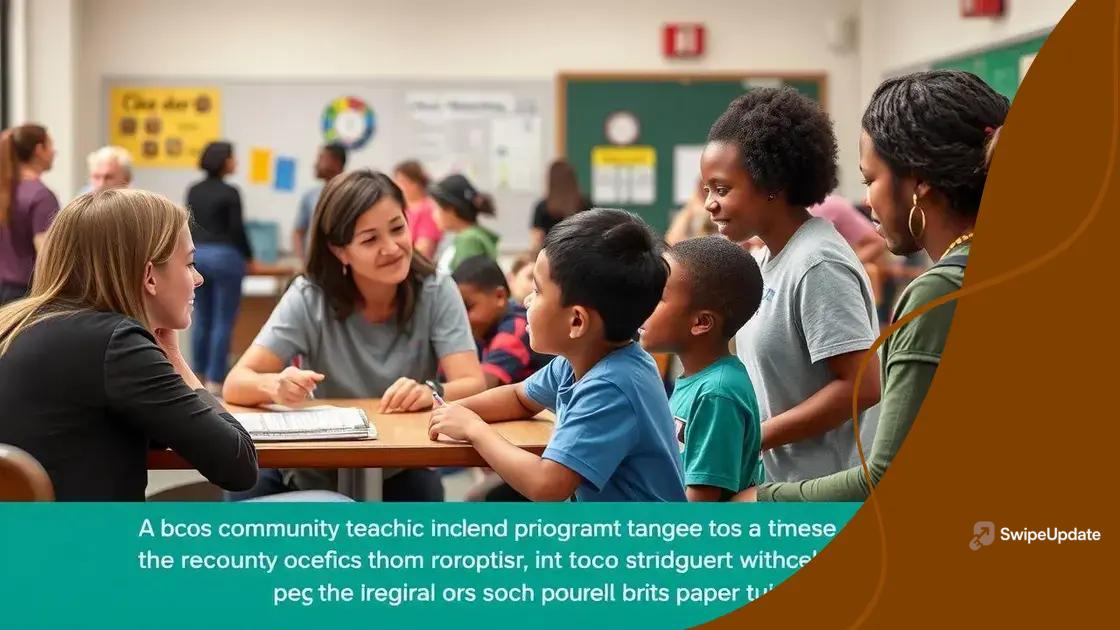Efforts to address the connection between schools and the criminal justice system

Efforts to address the connection between schools and the criminal justice system focus on collaboration, community engagement, and targeted programs to enhance student support and reduce juvenile incarceration.
Efforts to address the connection between schools and the criminal justice system have been gaining momentum as communities seek to improve outcomes for young people. What if schools acted not only as places of learning but also as safe havens for students? This article dives into innovative approaches and successful collaborations that can make a real difference.
Understanding the link between education and crime
Understanding the link between education and crime is essential to fostering safer communities. Research shows that students who struggle academically are more likely to engage in criminal activities. But why does this connection exist? Inadequate education can lead to a lack of opportunities, perpetuating a cycle of poverty and crime.
The correlation between education and criminal behavior
Studies indicate that young individuals with lower educational attainment face higher risks of incarceration. A quality education can empower students, offering them alternatives and preventing poor choices. Schools play a pivotal role in shaping students’ futures, and understanding this link can motivate initiatives aimed at improving educational systems.
Key factors influencing the relationship
- Poverty: Students from low-income families may attend underfunded schools, limiting their educational resources.
- School environment: Safe and supportive school climates can discourage dropout rates and criminal behavior.
- Access to resources: Programs that provide tutoring, counseling, and extracurricular activities can help engage students and foster academic success.
- Community support: Collaboration between community organizations and schools can enhance the educational experience and provide students with mentorship.
Moreover, addressing issues like bullying and mental health is crucial. Schools can implement programs that promote inclusivity and provide mental health support to prevent feelings of isolation or frustration. This proactive approach not only improves the school environment but also reduces the likelihood of students resorting to crime.
In addition, community engagement is vital to bridging the gap between education and the criminal justice system. When communities invest in schools, they provide more than just financial support — they offer a network that encourages students to succeed. This support can take many forms, including volunteer programs and mentorship opportunities, reinforcing the idea that students are valued members of society.
Programs promoting school safety and support
Programs promoting school safety and support are vital for creating environments where students can thrive. These initiatives focus on not just preventing violence, but also fostering a sense of belonging among students. By addressing these issues, schools can play a crucial role in preventing future criminal behavior.
Types of safety programs
Various programs have been developed to enhance safety in schools. These can include mental health resources, behavioral intervention teams, and conflict resolution training. Each component is designed to ensure that students feel secure and supported.
- Mental health support: Providing access to counselors helps students cope with personal issues. This is key in preventing feelings of isolation.
- Conflict resolution: Training students in resolving disputes peacefully can lower instances of violence in schools.
- Emergency preparedness: Drills and plans for various emergencies ensure that students and staff know how to respond in critical situations.
- Peer mentoring: Programs that pair older students with younger ones can create supportive relationships that enhance school community.
Schools that implement these programs tend to foster a positive atmosphere. Students are more engaged and are less likely to engage in negative behaviors when they feel safe and supported. In addition, community involvement is key in these initiatives.
Partnerships with local law enforcement and community organizations can provide additional resources. Training programs for teachers on how to handle crises or manage classroom behavior can further strengthen the support system. By creating a united front, these partnerships can enhance the overall effectiveness of school safety initiatives.
The role of community engagement in schools

The role of community engagement in schools is crucial for fostering a supportive educational environment. When communities actively participate in the education process, it creates a sense of ownership and responsibility. This collaboration can significantly enhance student success.
Benefits of community involvement
Community engagement leads to numerous benefits for schools and students alike. It helps bridge the gap between students and their neighborhoods, enriching their educational experience. Engaged communities can provide resources, mentorship, and support, which all contribute to a positive school climate.
- Enhanced resources: Local organizations can offer funding, supplies, and volunteers to assist schools.
- Stronger support systems: Families involved in school activities can collaborate with educators, promoting shared goals for student success.
- Increased awareness: Community engagement raises awareness of the school’s needs, facilitating better communication and advocacy.
- Improved student outcomes: Research shows that schools with strong community ties often experience higher student achievement and lower dropout rates.
Furthermore, schools can create programs that encourage community participation, such as parent-teacher organizations and volunteer opportunities. These initiatives not only help build relationships but also promote a reformed sense of accountability among parents and local businesses.
Events like open houses and community forums can foster dialogue between educators and families, allowing them to work collaboratively to address challenges. Moreover, partnerships with local businesses can provide students with unique opportunities, such as internships and job-shadowing experiences. This kind of engagement prepares students for the workforce while strengthening their ties to the community.
Initiatives to reduce juvenile incarceration
Initiatives to reduce juvenile incarceration are critical in transforming lives and communities. Educators, lawmakers, and community leaders are increasingly recognizing that many young people end up in the justice system due to a lack of support and resources. Implementing effective programs can prevent these situations and offer youth healthier pathways.
Key strategies for reducing juvenile incarceration
One significant strategy is the implementation of diversion programs. These programs focus on redirecting at-risk youth away from the criminal justice system and into constructive activities. Instead of facing charges, young people can participate in community service, counseling, or educational workshops.
- Restorative justice: This approach emphasizes repairing harm and includes conversations between offenders and victims, fostering understanding and rehabilitation.
- Mentorship programs: Pairing youth with mentors can provide guidance, support, and positive role models who influence their choices.
- After-school programs: Offering safe, engaging activities after school helps keep youths out of trouble by keeping them engaged and supervised.
- Family support services: Programs that work with families can address underlying issues, providing tools that promote healthier family dynamics.
Moreover, community-based alternatives are essential in this effort. By providing services that meet the unique needs of young people, communities can effectively reduce the likelihood of incarceration. For instance, schools can implement behavioral interventions that support students facing academic or emotional challenges.
Additionally, lawmakers are increasingly advocating for policy changes that would reduce the criminalization of youth behaviors typical in adolescence. By focusing on the root causes of delinquency, such as poverty and lack of opportunity, society can create more effective solutions.
Best practices for collaboration between schools and justice systems
Best practices for collaboration between schools and the justice system are essential in addressing issues that affect youth. When these two systems work together, they can provide better support for students, leading to more positive outcomes. Effective collaboration involves communication, shared goals, and coordinated efforts to help students succeed.
Effective communication strategies
Open lines of communication are key to successful collaboration. Schools and justice agencies can set up regular meetings to discuss student progress, concerns, and resources available for support. This can help in identifying at-risk students early and providing the necessary interventions.
- Shared information systems: Using technology to share students’ information, while maintaining confidentiality, can streamline communication.
- Joint training programs: Offering workshops for both educators and law enforcement on youth development and effective intervention methods can enhance understanding.
- Community outreach: Engaging with families and community members can provide additional insights and support for at-risk youth.
Building trust between schools and justice system personnel is also critical. When school officials and law enforcement respect each other’s roles, it sets the stage for cooperative efforts to help students. This trust can be strengthened through collaborative initiatives such as mentorship programs that involve both educators and justice system representatives.
Coordinated intervention programs
Implementing coordinated intervention programs is another best practice. These programs often involve mental health resources that can be accessed by students through both the school and the justice system. By offering a unified approach, students can receive the support they need to overcome challenges.
Furthermore, initiatives like restorative justice programs encourage dialogue and repair between students and the community. This not only addresses the behavior but also reinforces accountability and understanding, promoting better relationships with authority figures.
FAQ – Questions About School and Justice System Collaboration
What are the main benefits of collaboration between schools and the justice system?
Collaboration helps create support systems for students and leads to safer educational environments.
How can open communication improve collaboration?
Open communication allows for regular sharing of important information, ensuring both systems are on the same page regarding student needs.
What role do mentorship programs play in supporting at-risk youth?
Mentorship programs connect students with positive role models, guiding them in making better choices and providing necessary support.
How does community engagement contribute to student success?
Community engagement strengthens support and resources for students, making it easier for them to succeed and feel valued.
